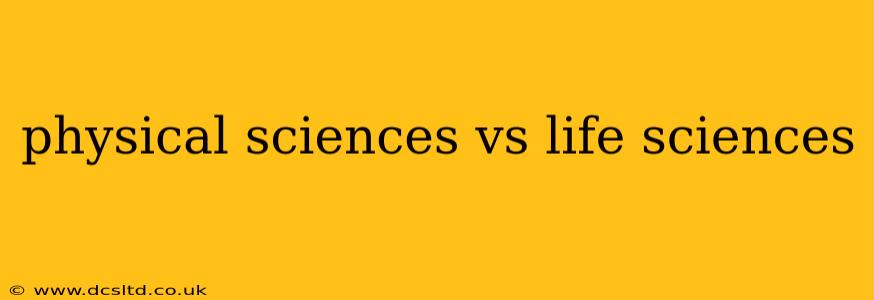The world of science is vast and multifaceted, often categorized into broad branches like physical sciences and life sciences. While both are crucial for understanding our universe and ourselves, they differ significantly in their focus, methodologies, and applications. This article will delve into the key distinctions between these two vital scientific fields, answering frequently asked questions along the way.
What are the Physical Sciences?
The physical sciences encompass the study of non-living systems and the fundamental forces governing the universe. They seek to understand the structure, properties, and behavior of matter and energy. Key disciplines within the physical sciences include:
- Physics: Explores the fundamental constituents of the universe, from subatomic particles to galaxies, and the laws governing their interactions. It delves into concepts like motion, energy, forces, and the nature of space and time.
- Chemistry: Investigates the composition, structure, properties, and reactions of matter. It explores elements, compounds, and molecules and their behavior under various conditions.
- Astronomy: Studies celestial objects and phenomena, including planets, stars, galaxies, and the universe as a whole. It uses observation and theoretical modeling to understand the cosmos.
- Earth Science (or Geoscience): Encompasses the study of Earth's composition, structure, processes, and history. This includes geology, meteorology, oceanography, and climatology.
What are the Life Sciences?
The life sciences, also known as biological sciences, focus on living organisms and their interactions with each other and their environments. They explore the complexity of life from the molecular level to ecosystems. Major branches of the life sciences include:
- Biology: The overarching field encompassing the study of all living things, including their structure, function, growth, origin, evolution, and distribution.
- Zoology: The study of animals, including their behavior, physiology, genetics, and evolution.
- Botany: The study of plants, covering their structure, function, growth, and reproduction.
- Microbiology: The study of microorganisms, including bacteria, viruses, fungi, and protozoa.
- Genetics: The study of heredity and variation in living organisms.
- Ecology: The study of the relationships between organisms and their environment.
- Biochemistry: The study of chemical processes within and relating to living organisms.
What is the difference between physical science and life science careers?
Career paths in physical and life sciences diverge significantly based on the subject matter and methodologies employed. Physical science careers often involve laboratory research, data analysis, and computational modeling. Examples include physicists working in particle accelerators, chemists developing new materials, or astronomers analyzing astronomical data. Life science careers, conversely, might involve fieldwork, laboratory research focused on biological systems, clinical studies, or developing new pharmaceuticals or biotechnological solutions.
How do physical and life sciences relate to each other?
Despite their differences, physical and life sciences are deeply intertwined. Biological processes are governed by physical and chemical laws. For example, biochemistry relies heavily on principles of chemistry and physics to understand the chemical reactions occurring within living organisms. Similarly, understanding the physical properties of molecules is crucial in fields like pharmacology and drug discovery. Many modern scientific advancements emerge from the collaborative efforts of researchers from both disciplines.
What are some examples of careers in physical science?
Examples of careers in physical science include:
- Physicist: Researching fundamental forces of nature or developing new technologies.
- Chemist: Developing new materials, pharmaceuticals, or chemical processes.
- Astronomer: Studying celestial objects and phenomena.
- Geologist: Investigating Earth's structure and resources.
- Meteorologist: Predicting weather patterns.
What are some examples of careers in life science?
Examples of careers in life science include:
- Biologist: Studying living organisms and their interactions.
- Biochemist: Investigating chemical processes in living organisms.
- Geneticist: Researching heredity and variation.
- Ecologist: Studying relationships between organisms and their environment.
- Physician: Diagnosing and treating diseases.
- Pharmacologist: Developing and testing new drugs.
Which is harder: physical science or life science?
The relative difficulty of physical science versus life science is subjective and depends on individual aptitudes and interests. Physical sciences often involve complex mathematical and theoretical concepts, while life sciences can require extensive memorization of biological details and intricate experimental procedures. Ultimately, success in either field depends on dedication, curiosity, and problem-solving skills.
This exploration provides a foundational understanding of the differences and interconnections between physical and life sciences. Both fields are vital for advancements in our understanding of the universe and our place within it, contributing significantly to technological progress and societal well-being.
